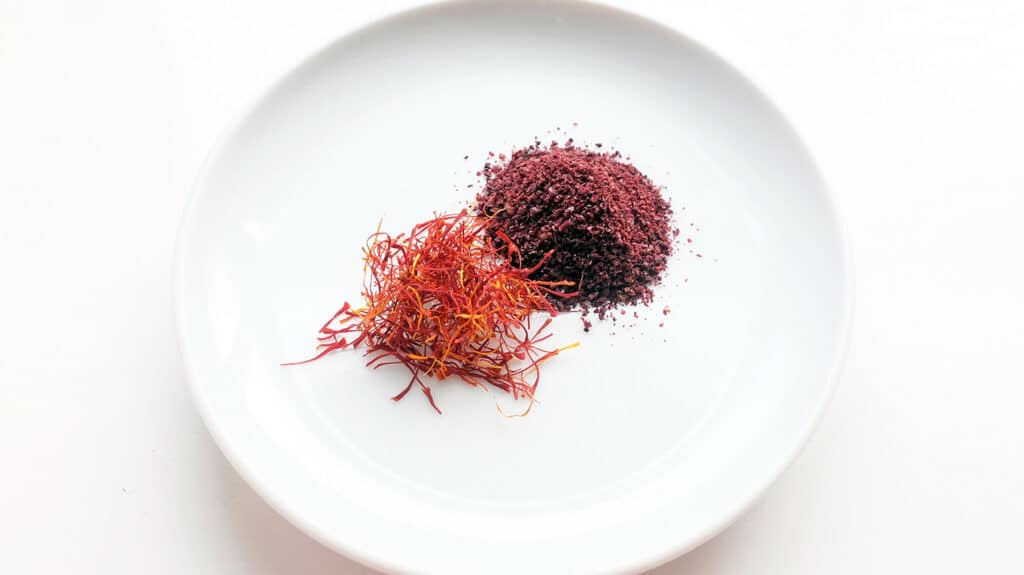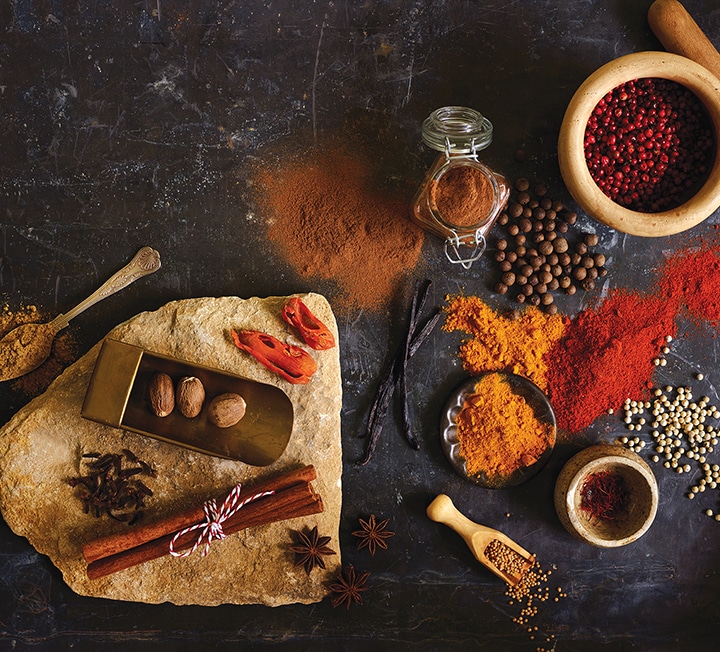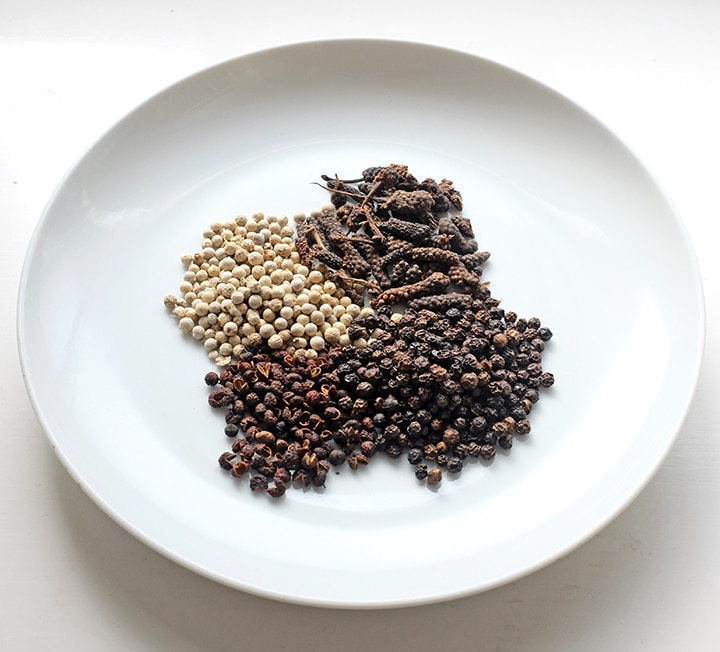The spice series: sumac & saffron
Ed Smith takes an in-depth look at the many spices available at the Market. This month: sumac and saffron


“THERE ARE ONLY THREE STIGMAS PER FLOWER, AND THEY MUST BE CAREFULLY PICKED ON THE FIRST MORNING THAT FLOWER BLOOMS”
These are two flavours that immediately bring to mind the heady tastes and indeed colours of the Levant. One, saffron, has been with us in the UK since the Middle Ages (and is even grown here). The other, sumac, is relatively new to these shores, but is set to become an essential component of every spice drawer, if it isn’t already.
Sumac
Technically, there are multiple varieties of the sumac bush, some of them poisonous, but we should side-step that detail and keep this simple.
As far as we’re concerned, the red, flaky powder you see on the shelves has been ground from the sun-dried (and very edible) sumac berries. It’s a spice that has been used as a condiment in Middle Eastern cooking for centuries, and one that has gained traction in the UK since Claudia Roden and Yotam Ottolenghi began to make Levantine cuisine a dinner party staple.
The first thing you think of when dabbing sumac to your lips is lemon, though it’s arguably more like a sharp apple – there’s a mellow, rounded acidity that enlivens anything it is sprinkled on or run through. It’s a cracking addition to food aesthetically too, as the flakes leave a bold red-maroon colour trail wherever they’re scattered.
Not all ground sumac is created equal; once you’ve tasted a particularly potent version, you’ll know what I mean. Thankfully, the sumac sold at Spice Mountain and Arabica is of excellent quality.
Generally, sumac comes in flaky powder form, which, as with most of the ground spices in this series, lasts reasonably well for six to 12 months in an airtight container. It’s sometimes possible to pick up branches of whole sumac berries, which could be reconstituted, crushed lightly and the juice used in stews or sauces.
Some recipes will call for sumac to be used in a marinade. It has most impact, though, when sprinkled liberally as a condiment at the end of the cooking process. Sumac can also be mixed with olive oil or yoghurt to create a ruby coloured slick of flavour, again to lash your food with just before eating.
In countries like Lebanon, Israel, Turkey and Iran, sumac is as common on home tables as salt and pepper are on ours. I wouldn’t be surprised if, in 20 years’ time, there’ll be pinch pots of it at most meal times over here too.
Saffron
We know, of course, that saffron is one of the most expensive, if not the most expensive spice per gram. Have you given thought to why that is?
Those orangey-red threads are the stigma of the crocus sativus. There are only three stigmas per flower, and they must be carefully picked on the first morning that flower blooms, before the flower wilts, or rains or frost ruin the crop. Moreover, before the stigmas are picked, each flower needs to be bred and nurtured by human hand, and the drying and storing process appears to be just as labour intensive and time consuming. It’s perhaps no surprise to read in John O’Connell’s The Book of Spice, that it takes around 150 flowers to produce a gram of saffron.
Saffron was originally cultivated in Kashmir, and that remains a region famous for the spice. Iran now dominates with over 90 per cent of production. But other countries are in on the act as well, not least Spain and Greece. There’s even a boutique industry in Essex too – Saffron Walden (of course!) is historically famed for growing and harvesting the right type of iris.
Why all the fuss? Saffron would not be such a highly priced spice were it not for its prized flavour. The delicate threads emit complex notes of honey, dried meadow grass and bittersweet flowers. I have to say, I also get toilet cleaner on the nose and a metallic tinny taste when saffron dominates rather than supports (which is much of the time). But perhaps that’s just me.
This spice requires a liquid to make the most of its flavour – in contrast to sumac, saffron is not for sprinkling over dry food at the last minute. The Persians, probably the original users of the flavour, have it right when they temper a few threads for at least 15 minutes in a spoonful of boiling water, before adding it to their dish (often rice, but also stews).
There are a number of places to buy saffron in the Market. Spice Mountain stocks both Iranian and Kashmiri crocuses. Oliveology has a Greek variety, and Brindisa has saffron from La Mancha, Spain. I suspect most packs you have include a ‘best before’ date on them. Of course, these things are best used relatively quickly, though I’ve found old threads seem to come back to life using the boiling method. And this is one spice that I wouldn’t chuck out in a spring clean.
Culinary uses
Sumac brightens many savoury flavours. Expect, though, to see it sprinkled over lamb or chicken, hummus, yoghurt-based dips, fennel or onions, or added to anything where there’s already lemon or oranges involved, thereby added a more complex layer of acidity. It’s a wonderful addition to already well-oiled or buttered hot bread.
Sumac is a vital part of the za’atar spice mix, which also features sesame seeds, dried thyme and sometimes oregano and salt. Again, this is generally used as a condiment, sprinkled with abandon over meats, vegetables and fish, or mixed into olive oil to use as a dip for bread.
We associate sumac with Middle Eastern cooking and indeed most of the classic uses stem from this. One of my favourite dishes involving sumac comes from Turkish grills, where onions are burnt but still retain a little crispness, and are then dressed with pomegranate molasses, loads of sumac and parsley. It’s savoury, sweet and sour all at the same time. Sumac also adds a great deal to fattoush, that Levantine bread and parsley salad which should be tart enough to make your lips pucker. And I wonder whether it might also be used on sweet dishes too?
There are some key ingredient and flavour pairings for saffron that are worth remembering – if you’ve spent your pocket money on a little pack, you should use the threads wisely. In The Flavour Thesaurus, Niki Segnit mentions that saffron goes well with almonds, anise (think fennel), cauliflower, chicken, white fish, orange, potatoes, rosewater and shellfish. I agree with all of that.
Classic dishes using saffron all stem from the spice route, and quite probably all derived from Persian cuisine. So a tah-dig, that crisp-bottomed Persian rice, and other pilafs may have prompted Italian traders to create the Milanese risotto, which is served underneath yielding veal shin. Other rice-based dishes such as Spanish paella and Indian biryanis take their signature colour and aroma from just a few threads of saffron, and could well have taken their lead from the tah-dig.
Spanish seafood stews often have a hint of saffron in them. As does a proper bouillabaisse from Marseille, France. And we see saffron employed in many classic baked and sweet recipes too – loaves enriched with milk and saffron, saffron and almond cakes, and numerous ice creams and dairy based puddings and drinks.
We should also mention Cornish saffron cake / bread, a historic product, which shows that this spice has been used in the UK for centuries.
Market spice heroes
It’s hard to look past Arabica when it comes to sumac. James Walters has been trading at Borough for over 15 years, with sumac to the fore, and it continues to be sprinkled as a condiment over many of the restaurant’s dishes.
As mentioned above, you can buy a variety of different types of saffron at the Market. But look also for products that use the crocuses to great effect – like Brindisa’s saffron mayonnaise, which is excellent when dolloped next to lobster, or perhaps onto garlicky toasts sitting atop of a fish and clam stew.
Specific recipes to look out for
Any well-used Spanish or Middle Eastern cookbook will be stained with saffron. Great recipes from my collection include:
— The picada and the fishermen’s stew it flavours in Monika Linton’s encyclopedic Brindisa: The True Food of Spain.
— I love Sabrina Ghayour’s saffron chick, fennel and barbary stew in Persiana
— Sumaya Usmani utilises saffron in many of her recipes in Summers Under the Tamarind Tree. From the savoury (nutty saffron rice), to the sweet (saffron bread pudding and saffron halva).
— Yoghurt, a little water and icing sugar makes a bright yellow yet mellowing drink.
— And back to Spain: In The Food of Spain, saffron gives both name and flavour to Claudia Roden’s Malagan pescado en amarillo.
Although you’ll find that it’s mostly just suggested as a condiment or seasoning, sumac crops up in some lovely recipes too:
— Along with Claudia Roden, we probably have Yotam Ottolenghi to thank for the prevalence of sumac on our shelves, now. His version of Palestinan m’sakhan in Ottolenghi: The Cookbook is probably the place to start for a classic roast chicken with sumac, za’atar and lemon.
— Also note the sour cream and sumac sauce that goes with the same food writer’s turkey and courgette burgers in Jerusalem.
— Check out the use of sumac-macerated onions in a mackerel baguette in Rick Stein’s From Venice to Istanbul.
See Ed’s recipe for my sumac & hazelnut meringues.


